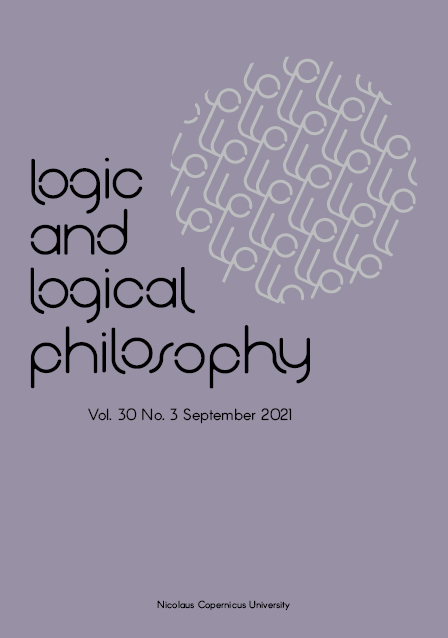Extension and Self-Connection
DOI:
https://doi.org/10.12775/LLP.2021.008Keywords
mereology, mereotopology, extensionalism, universalism, connection, self-connectionAbstract
If two self-connected individuals are connected, it follows in classical extensional mereotopology that the sum of those individuals is self-connected too. Since mainland Europe and mainland Asia, for example, are both self-connected and connected to each other, mainland Eurasia is also self-connected. In contrast, in non-extensional mereotopologies, two individuals may have more than one sum, in which case it does not follow from their being self-connected and connected that the sum of those individuals is self-connected too. Nevertheless, one would still expect it to follow that a sum of connected self-connected individuals is self-connected too. In this paper, we present some surprising countermodels which show that this conjecture is incorrect.
References
Blumson, Ben, and Manikaran Singh, 2020, “Whitehead’s principle”, Thought: A Journal of Philosophy 9 (2): 115–127. DOI: http://dx.doi.org/10.1002/tht3.450
Casati, Roberto, and Achille C. Varzi, 1999, Parts and Places. The Structures of Spatial Representation, MIT Press: Cambridge, Mass.
Clarke, Bowman L., 1981, “A calculus of individuals based on “connection”, Notre Dame Journal of Formal Logic 22 (3): 204–218. DOI: http://dx.doi.org/10.1305/ndjfl/1093883455
Cotnoir, Aaron J., 2010, “Anti-symmetry and non-extensional mereology”, The Philosophical Quarterly 60 (239): 396–405. DOI: http://dx.doi.org/10.1111/j.1467-9213.2009.649.x
Cotnoir, Aaron J., 2013, “Strange parts: The metaphysics of non-classical mereologies”, Philosophy Compass 8 (9): 834–845. DOI: http://dx.doi.org/10.1111/phc3.12061
Cotnoir, Aaron J., 2016, “Does universalism entail extensionalism?”, Noûs, 50 (1): 121–132. DOI: http://dx.doi.org/10.1111/nous.12063
Cotnoir, Aaron J., 2018, “Is weak supplementation analytic?”, Synthese 50: 121–132. DOI: http://dx.doi.org/10.1007/s11229-018-02066-9
Hovda, Paul, 2009, “What is classical mereology?”, Journal of Philosophical Logic 38 (1): 55–82. DOI: http://dx.doi.org/10.1007/s10992-008-9092-4
Kearns, Stephen, 2011, “Can a thing be part of itself?” American Philosophical Quarterly 48 (1): 87–93.
Ben Blumson and Manikaran Singh Lando, Giorgio, 2018, Mereology: A Philosophical Introduction, Bloomsbury: London.
Leonard, Henry S., and Nelson Goodman, 1940, “The calculus of individuals and its uses”, The Journal of Symbolic Logic 5 (2): 45–55. DOI: http://dx.doi.org/10.2307/2266169
Leśniewski, Stanisław, 1991, “On the foundations of mathematics”, pages 174–382 in S. Surma, J. Srzednicki, D. Barnett, V. Rickey (eds.), Collected Works, vol. I, Nijhoff International Philosophy Series, no. 44, Kluwer Academic Publishers: Dordrecht, Boston, London. English version of Polish Leśniewski’s works “O podstawach matematyki”, Przegląd Filozoficzny, 39–34, 1927–1931: 164–206, 261–291, 60–100, 77–105, 142–170.
Lewis, David 1986, On the Plurality of Worlds, Blackwell: Oxford.
Lewis, David, 1991, Parts of Classes, Blackwell: Oxford.
Masolo, Claudio, and Laure Vieu, 1999, “Atomicity vs. infinite divisibility of space”, pages 235–250 in Spatial Information Theory Cognitive and Computational Foundations of Geographic Information Science, Lecture Notes in Computer Science, Springer: Berlin. DOI: http://dx.doi.org/10.1007/3-540-48384-5_16
Parsons, Josh, 2014, “The many primitives of mereology”, in Mereology and Location, Oxford University Press: Oxford.
Parsons, Josh, draft, “An extensionalist’s guide to non-extensional mereology”.
Pietruszczak, Andrzej, 2005, “Pieces of mereology”, Logic and Logical Philosophy 14 (2): 211–234. DOI: http://dx.doi.org/10.12775/LLP.2005.014. English version of “Kawałki mereologii”, pages 357–374 in J. Perzanowski and A. Pietruszczak (eds.), Logika & Filozofia Logiczna: FLFL 1996–1998, Wydawnictwo UMK: Toruń, 2000.
Pietruszczak, Andrzej, 2018, Metamereology, Nicolaus Copernicus University Scientific Publishing House: Toruń. DOI: http://dx.doi.org/10.12775/3961-4. English version of Metamereologia, Wydawnictwo UMK: Toruń, 2000.
Pietruszczak, Andrzej, 2020, Foundations of the Theory of Parthood. A Study of Mereology, Trends in Logic, vol. 54, Springer International Publishing. DOI: . http://dx.doi.org/10.1007/978-3-030-36533-2 Revised and extended edition of Podstawy teorii części, Wydawnictwo Naukowe UMK: Toruń, 2013.
Pontow, Carsten, 2004, “A note on the axiomatics of theories in parthood”, Data & Knowledge Engineering 50 (2): 195–213. DOI: http://dx.doi.org/10.1016/j.datak.2003.12.002
Simons, Peter, 1987, Parts: A Study in Ontology, Oxford University Press: Oxford.
Tarski, Alfred, 1956, “Foundations of the geometry of solids”, pages 24–29 in J.H. Woodger (ed.), Logic, Semantics, Metamathematics. Papers from1923 to 1938, Oxford: Oxford UniversityPress. English version of “Les fondements de la géométrie des corps”, pages 29–30 in Księga Pamiątkowa Pierwszego Zjazdu Matematycznego, Kraków, 1929.
Thomson, Judith Jarvis, 1998, “The statue and the clay”, Noûs 32 (2): 149–173. DOI: http://dx.doi.org/10.1016/j.datak.2003.12.002
Varzi, Achille C., 1996, “Parts, wholes, and part-whole relations: The prospects of mereotopology”, Data & Knowledge Engineering 20 (3): 259–286. DOI: http://dx.doi.org/10.1016/S0169-023X(96)00017-1
Varzi, Achille C., 2006, “A note on the transitivity of parthood”, Applied Ontology 1: 141–146.
Varzi, Achille C., 2009, “Universalism entails extensionalism”, Analysis 69 (4): 599–604. DOI: http://dx.doi.org/10.1093/analys/anp102
Varzi, Achille C., 2019, “On three axiom systems for classical mereology”, Logic and Logical Philosophy 28 (2): 203–207. DOI: http://dx.doi.org/10.12775/LLP.2018.014
Whitehead, Alfred North, and Bertrand Russell, 1925, Principia Mathematica, 2ed, vol. 1, Cambridge University Press: Cambridge.
Whitehead, Alfred North, 1929, Process and Reality: An Essay in Cosmology, Macmillan: New York.
Downloads
Published
How to Cite
Issue
Section
Stats
Number of views and downloads: 831
Number of citations: 1







